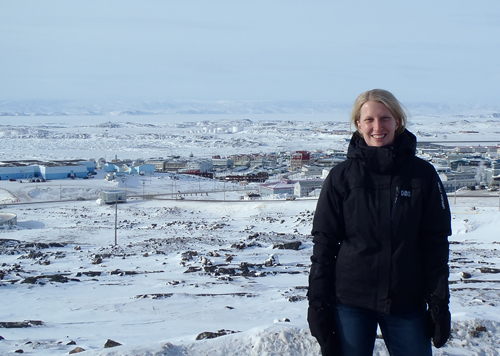
We know climate change is happening, but here in Southern Ontario, we haven’t worried much about the impact it could have on our health.
That’s not true in other parts of the world. New U of G professor Sherilee Harper, Population Medicine, is researching the effects of climate change on health in indigenous populations in different parts of the planet. “My area is water-borne diseases and water security – having enough safe water for drinking and hygiene,” Harper says. She finds that some populations are already struggling to cope with the effects of warmer temperatures and more extreme weather.
“A one-degree change in temperature doesn’t mean much here, but in the Arctic, it can be huge. It can mean the difference between ice and no ice at certain times of the year,” explains Harper. For example, there are deep caves near the community she studied that used to be a source of ice for the community in warmer weather, but now the ice is all melted. “When you have a culture and a community that are so dependent on and connected to the environment, the changes become more significant.”
Growing up in rural Grey County gave Harper an early understanding of the links between human, animal and environmental health. During her undergraduate studies in biology at Queen’s University, she discovered a love of research that naturally propelled her into graduate work at U of G. She earned both a master’s and a PhD in epidemiology studying the relationships among weather patterns, water quality and health in northern Canadian communities.
Her current project is part of an international collaboration with McGill University and researchers in Peru and Uganda. “We are all studying different aspects of how climate change affects health,” she explains.
Her approach to research is not the standard one. As an undergrad, Harper spent a semester in Kenya, where she learned the importance of engaging with the community. By working with the local people, she is able to get a better sense of what information is likely to be valuable, how to collect it and how to put it in context. That collaborative approach also provides opportunities to share the results of her work with the people who can directly benefit from it.
For the past eight years, Harper has been spending time in the Arctic. “Some of the community members are like family to me now,” she says. She’s fallen in love with the beautiful landscapes and the strong culture of the people she’s met.
Through her research, she’s learned that climate change has led to more rain in the area. And after a heavy rainstorm, the bacteria levels in the local brooks and streams are higher than usual. Visits to the local health clinics for diarrhea and other stomach problems also increase during this time. While most of the residents do have tap water, drinking from the streams is common, especially when people are hunting or camping.
What’s the best way to warn people about the danger? “Our initial thought was that we would create some brochures telling people not to drink from the brooks,” Harper says. The team met with local high school students, who laughed at the idea. “They said brochures would just get thrown in the fire.”
Instead, the students suggested a campaign with posters, stickers and public service announcements on the radio. The posters used photos of people from the community, and the messaging the students suggested was: “After heavy rain, treat the brook water before you drink it.”
Harper says this was a more informative and nuanced message than they had originally intended to use, but it made more sense to the community. “And because the students had been involved in creating this campaign, they would talk to their families and friends about it, so the message was shared that way as well.”
In 2011, Harper travelled to Uganda to work with researchers there. “We used the same type of approach, asking community members about their priorities,” she says. The research team asked the local people to take and caption photos illustrating how the environment was affecting their health. The top items on their list: food insecurity, vector-borne illnesses such as malaria, and food and water-borne diseases.
What struck Harper most about that list was how similar it was to the concerns of the Inuit people in the Arctic. “Different countries, different climates, different cultures, and yet their priorities were very similar. Climate change is affecting water quality and food security for indigenous communities – who are already facing problems in these areas – all around the world.”
The data-gathering part of this five-year project is now largely completed, and Harper says the next two years will be focused on trying to move the research findings forward into government policy and making changes to support people’s health and well-being.
Meanwhile, Harper is looking at expanding her work in the Arctic in partnership with Prof. Jan Sargeant, director of the Centre for Public Health and Zoonoses and a faculty member in the Department of Population Medicine. “We want to figure out where the pathogens in the water that make people sick are coming from,” says Harper. “Is it from caribou, from the dogs? Finding that may help us develop more preventive measures.”
Harper’s husband is an engineer who also works in Uganda and the Arctic on water projects. They spend a lot of time with people living in such different environments – people she obviously admires and has great affection for. “The Inuit culture is all about adapting,” she says.
Harper feels her research is a perfect fit for the Ontario Veterinary College because of its expertise in microbial organisms and its focus on One Health: the interconnectedness of environmental, animal and human health. “They really can’t be separated,” Harper says.
To learn more about Harper’s research, visit her website: http://sherileeharper.com.